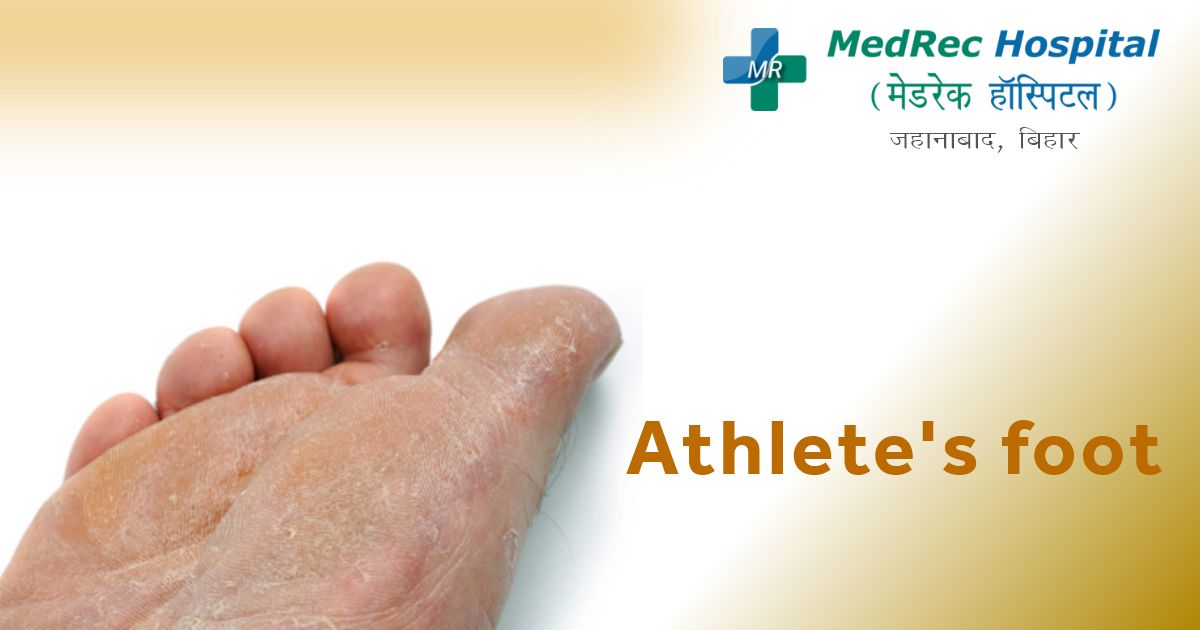
Athletes Foot : A common condition that impacts many people's feet
811
A fungal skin illness called athlete's foot starts between the toes. People who have extremely sweaty feet and tight-fitting shoes are more likely to develop it.
One of the warning indications and symptoms of athlete's foot is an itchy, scaly rash. It can be contagious and spreadable by contaminated surfaces, linens, or clothes.
Athlete's foot is strongly connected to other fungal illnesses such as ringworm and jock itch. Although it may be treated with antifungal medications, the condition usually recurs.
Causes
The same kind of fungus that causes jock itch and ringworm can cause athlete's foot. The organisms develop best in warm, humid environments and in wet socks and shoes.
Contagious surfaces like towels, floors, and shoes can also transmit athlete's foot. Additionally, contact with an infected person can spread it. You run the risk of spreading the infection to other parts of your body if you scratch or pick at the infected areas of your foot.
How to check if you have Athlete's Foot?
Consult a doctor if the rash on your foot does not go away after two weeks of self-care using an over-the-counter antifungal solution.
If you think you could develop athlete's foot and have diabetes, visit your doctor right away. Additionally, if you exhibit symptoms of an infection like fever, pus, or an enlarged afflicted region, please consult your doctor.
Risk Factors
Athlete's foot is more likely to affect you if you:
- Wear enclosed footwear often
- If you sweat a lot
- If you share footwear, bedsheets, carpets, mats, or clothing with someone who has a fungal infection.
- If you visit public spaces without protection. In these areas the infections might spread, such as showers, saunas, swimming pools, and public baths, if you keep your feet bare.
Symptoms
Both feet may be impacted by the athlete's foot.
Common signs and symptoms include:
- Skin that is flaky, peeling, or cracked between the toes
- Itching, especially after removing shoes and socks
- Depending on your skin tone, inflamed skin may seem reddish, purple, or grey.
- Stinging or burning
- Blisters
- On the bottom of the foot, there is dry, scaly skin that encroaches on the foot's skin.
Prevention
These following tips can aid in preventing athlete's foot and preventing the transmission of it to others:
- Allow your feet to breathe. Wear sandals whenever you can to provide as much airflow as possible for your feet.
- Wash your feet regularly. To thoroughly clean and dry your feet, especially in the space in between your toes, use warm, soapy water.
- Regularly replace your socks. If your feet feel particularly hot, you should change your socks more frequently than once per day.
- Wear new shoes every day. As a result, your shoes have time to dry out between being worn.
- On public property, keep your feet covered. Around public swimming pools, showers, and locker rooms, wear waterproof sandals or shoes.
- Know the potential sources of disease transmission. Avoid sharing shoes, dirty sheets, or dirty towels if you live with others.
Treatments
You may need to visit a doctor to obtain a prescription-strength cream or ointment, such as clotrimazole (Lotrisone), econazole (Ecoza, Spectazole), or ciclopirox if your athlete's foot doesn't react to over-the-counter remedies and self-care. Your doctor can recommend antifungal medications like terbinafine (Lamisil) or itraconazole if you have a more serious infection.
You can lessen athlete's foot symptoms or prevent a recurrence by following these recommendations:
Keep your feet dry and spotless. Wash your feet twice daily, then gently pat dry between the toes with a towel.
Make use of an anti fungal product. Apply an antifungal product to your feet after washing and drying them.
Regularly replace your socks. If your feet feel particularly hot, you should change your socks more frequently than once per day.
Put on light-weight footwear. Avoid wearing shoes made of synthetic materials like rubber or vinyl. When feasible, wear sandals to allow your feet to breathe.
several pairs of footwear.
Wear new shoes every day. As a result, your shoes have time to dry out between wears.
On public property, keep your feet covered. Around public swimming pools, showers, and locker rooms, wear waterproof sandals or shoes.
Avoid scratching the rash. Try soaking your scratchy feet in cold water to help them feel better.
Never swap shoes. Sharing puts you at danger of spreading a fungus.
Complications of Athletes' Foot
Warm and wet regions of the body are susceptible to the athlete's foot infection. Athlete's foot and jock itch are frequently brought on by the same fungus. The fungus can spread by hands or towels and it is typical for the illness to go from the feet to the groin.
Occasionally, an athlete's foot might result in bacterial infections.
For further information please access the following resources:
Emergency : +91 89686 77907
Front Desk : +91 98018 79584
Page last reviewed: Mar 6, 2023
Next review due: Mar 6, 2025







.jpg)
.jpg)
.jpg)
.jpg)
.jpg)
.jpg)